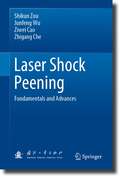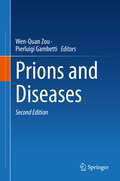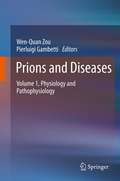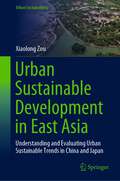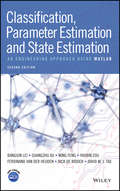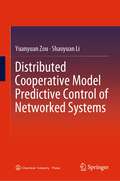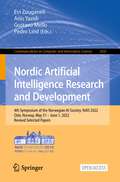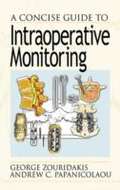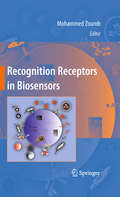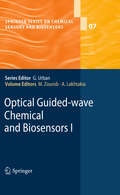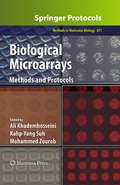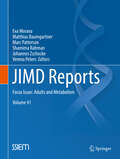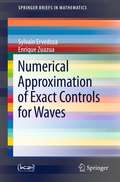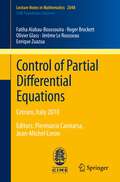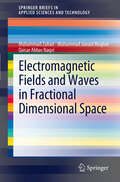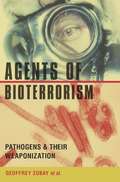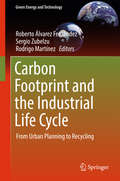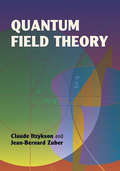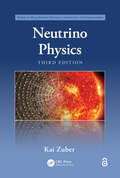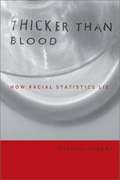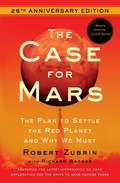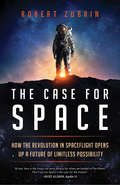- Table View
- List View
Laser Shock Peening: Fundamentals and Advances
by Shikun Zou Junfeng Wu Ziwei Cao Zhigang CheThis book highlights the fundamentals and latest progresses in the research and applications of laser shock peening (LSP). As a novel technology for surface treatment, LSP greatly improves the resistance of metallic materials to fatigue and corrosion. The book presents the mechanisms, techniques, and applications of LSP in a systematic way. It discusses a series of new progresses in fatigue performance improvement of metal parts with LSP. It also introduces lasers, equipment, and techniques of newly developed industry LSP, with a detailed description of the novel LSP blisk. The book demonstrates in details numerical analysis and simulation techniques and illustrates process stability control, quality control, and analysis determination techniques. It is a valuable reference for scientists, engineers, and students in the fields of laser science, materials science, astronautics, and aeronautics who seek to understand, develop, and optimize LSP processes.
Prions and Diseases
by Wen-Quan Zou Pierluigi GambettiTransmissible spongiform encephalopathies (TSE), known as prion diseases, have been recognized for nearly 300 years in animals and almost 100 years in humans. Modern studies, including the protein-misfolding cyclic amplification (PMCA), have greatly advanced our understanding of the pathogenesis of prion diseases and facilitated the identification of new prion diseases in animals and humans. In the second edition of Prions and Diseases, more than 60 leading researchers and clinicians worldwide provide an up-to-date discussion of these unique infectious pathogens and their associated diseases. The book provides up-to-date knowledge about the etiology, pathogenesis, classification, histopathological, and clinical aspects of the full range of animal and human prion diseases. As a result, the book contains by far the most authoritative views about the past, present, and future of prions and prion diseases. The new second edition covers such important emerging topics such as inherited human prion disease, stem-cell models in prion research, human prion disease surveillance, and gene therapy strategies.
Prions and Diseases: Volume 1, Physiology and Pathophysiology
by Wen-Quan Zou Pierluigi GambettiVolume I highlights the association of the cellular prion protein (PrPC) with copper and zinc, the potential roles of PrPC in Alzheimer's disease and cancers, insoluble PrPC, PMCA, molecular and cellular mechanisms of PrPSc formation and clearance, possible co-factors involved in the conversion of PrPC into PrPSc, infectious and pathogenic forms of PrP, cell biology of prions, prion strains and their interference, as well as yeast prions and their inheritable and structural traits. This unique volume will take you through the fascinating chronicle of prions in mammals, yeast, and fungi.
Urban Sustainable Development in East Asia: Understanding and Evaluating Urban Sustainable Trends in China and Japan (Urban Sustainability)
by Xiaolong ZouThis book offers careful glimpse from the lenses of selected case studies of major counties in East Asia, namely China and Japan to obtain insights as well as lessons regarding their perspective sustainable cities development. Urban sustainability is the pillar domain for achieving overall sustainability. East Asia has the world most populous countries and cities; therefore, it is of great importance to understand, analyze, and assess the sustainable urban development trends and paradigms in an East Asia setting so as to better guide the future development of sustainable cities in the region. The outcomes of this book are policy-relevant consultations to key stakeholders from various walks of sustainability studies.
Classification, Parameter Estimation and State Estimation: An Engineering Approach Using MATLAB
by Yaobin Zou Ming Feng Guangzhu Xu Ferdinand van der Heijden Dick De Ridder David M. Tax Bangjun LeiA practical introduction to intelligent computer vision theory, design, implementation, and technology The past decade has witnessed epic growth in image processing and intelligent computer vision technology. Advancements in machine learning methods—especially among adaboost varieties and particle filtering methods—have made machine learning in intelligent computer vision more accurate and reliable than ever before. The need for expert coverage of the state of the art in this burgeoning field has never been greater, and this book satisfies that need. Fully updated and extensively revised, this 2nd Edition of the popular guide provides designers, data analysts, researchers and advanced post-graduates with a fundamental yet wholly practical introduction to intelligent computer vision. The authors walk you through the basics of computer vision, past and present, and they explore the more subtle intricacies of intelligent computer vision, with an emphasis on intelligent measurement systems. Using many timely, real-world examples, they explain and vividly demonstrate the latest developments in image and video processing techniques and technologies for machine learning in computer vision systems, including: PRTools5 software for MATLAB—especially the latest representation and generalization software toolbox for PRTools5 Machine learning applications for computer vision, with detailed discussions of contemporary state estimation techniques vs older content of particle filter methods The latest techniques for classification and supervised learning, with an emphasis on Neural Network, Genetic State Estimation and other particle filter and AI state estimation methods All new coverage of the Adaboost and its implementation in PRTools5. A valuable working resource for professionals and an excellent introduction for advanced-level students, this 2nd Edition features a wealth of illustrative examples, ranging from basic techniques to advanced intelligent computer vision system implementations. Additional examples and tutorials, as well as a question and solution forum, can be found on a companion website.
Distributed Cooperative Model Predictive Control of Networked Systems
by Yuanyuan Zou Shaoyuan LiThis book is inspired by the development of distributed model predictive control of networked systems to save computation and communication sources. The significant new contribution is to show how to design efficient DMPCs that can be coordinated asynchronously with the increasing effectiveness of the event-triggering mechanism and how to improve the event-triggered DMPC for different requirements improvement of control performance, extension to interconnected networked systems, etc. The book is likely to be of interest to the persons who are engaged in researching control theory in academic institutes, the persons who go in for developing control systems in R&D institutes or companies, the control engineers who are engaged in the implementation of control algorithms, and people who are interested in the distributed MPC.
Axial Turbine Aerodynamics for Aero-engines: Flow Analysis and Aerodynamics Design
by Zhengping Zou Songtao Wang Huoxing Liu Weihao ZhangThis book is a monograph on aerodynamics of aero-engine gas turbines focusing on the new progresses on flow mechanism and design methods in the recent 20 years. Starting with basic principles in aerodynamics and thermodynamics, this book systematically expounds the recent research on mechanisms of flows in axial gas turbines, including high pressure and low pressure turbines, inter-turbine ducts and turbine rear frame ducts, and introduces the classical and innovative numerical evaluation methods in different dimensions. This book also summarizes the latest research achievements in the field of gas turbine aerodynamic design and flow control, and the multidisciplinary conjugate problems involved with gas turbines. This book should be helpful for scientific and technical staffs, college teachers, graduate students, and senior college students, who are involved in research and design of gas turbines.
Nordic Artificial Intelligence Research and Development: 4th Symposium Of The Norwegian Ai Society, Nais 2022, Oslo, Norway, May 31-june 1, 2022, Revised Selected Papers (Communications In Computer And Information Science Series #1650)
by Evi Zouganeli Anis Yazidi Gustavo Mello Pedro Lind<p>This book constitutes the refereed proceedings of the 4th Symposium of the Norwegian AI Society, NAIS 2022, held in Oslo, Norway, during May 31–June 1, 2022.<p> <p>The 11 full papers included in this book were carefully reviewed and selected from 17 submissions. They were organized in topical sections as follows: robotics and intelligent systems; ai in cyber and digital sphere; ai in biological applications and medicine; and towards new ai methods.<p>
A Concise Guide To Intraoperative Monitoring
by George Zouridakis Andrew PapanicolaouCovering both the applications and the related theory, A Concise Guide to Intraoperative Monitoring provides a general but comprehensive introduction to IOM. Unlike existing texts that typically report the results of specific studies, this book presents comprehensive coverage of the entire procedure, as well as the specific protocols used in hospital practice, examples of typical recordings, possible problems, and recommended solutions. At the end of each chapter the author poses several questions for review. These questions help technologists and medical residents in their preparation for the board exams. Taken together, these features make the book an ideal reference or training manual. <p><p> A Concise Guide to Intraoperative Monitoring begins by discussing the basic principles underlying the generation of bioelectrical signals. It then describes the electronic equipment and the various electrophysiological procedures involved in IOM. From this foundation, the book gradually advances to more specific topics, such as surgical procedures, neuronal structures at risk, the optimum combinations of tests to administer, and the proper interpretation of test results. The material also provides you with a background on general anesthesia and analyzes the effects of various drugs on electrophysiological recordings. A Concise Guide to Intraoperative Monitoring also discusses the proper placement of stimulation and recording electrodes, as well as intervention strategies and equipment troubleshooting.
Recognition Receptors in Biosensors
by Mohammed ZourobThis book will cover most of the up-to-date recognition receptors technologies used in biosensors. Since this book is written by the world's most renowned and learned scientists in their own area of expertise, we believe that the calibre of the finished product will be as renowned as their reputation. To the best of the editor and author's knowledge this book is a first in this field. We will aim to cover this increasingly hot area of research especially in relation to the new biosensing techniques. Most of the universities are teaching the recognition receptors topics in the Biosensors, separation and Microsystems courses. However, there is no single reference book that covers this interesting area. So the aim of this book is to be a textbook for the undergraduate and graduate student upwards, and an important reference for the professionals working in different fields including biomedical, natural sciences, physical sciences, and nanotechnology, m-TAS, veterinary, food QA, bioterrorism and security as well as health surveillance. The book will cover the different recognition receptors used up-to-date in the different sensing transducer and microarrays platforms. It will cover the background, theory behind each technology, state-of-the-art review for all the new technologies used in biosensing in detail. Strategies and future prospectus are suggested at the end of each chapter for developing future technologies to achieving a better sensitivity, stability and swifter biosensing detection.
Optical Guided-wave Chemical and Biosensors I
by Mohammed Zourob Akhlesh LakhtakiaFor the first time, distinguished scientists from key institutions worldwide provide a comprehensive approach to optical sensing techniques employing the phenomenon of guided wave propagation for chemical and biosensors. This includes both state-of the-art fundamentals and innovative applications of these techniques. The authors present a deep analysis of their particular subjects in a way to address the needs of novice researchers such as graduate students and post-doctoral scholars as well as of established researchers seeking new avenues. Researchers and practitioners who need a solid foundation or reference will find this work invaluable. This first of two volumes contains eight chapters covering planar waveguides for sensing, as well as sensing techniques based on plasmonic waveguides.
Biological Microarrays: Methods and Protocols (Methods in Molecular Biology #671)
by Mohammed Zourob Kahp-Yang Suh Ali KhademhosseiniRecent developments in microarray technology have changed the landscape of biology and biomedical research, and they have revolutionized RNA and DNA research. In Biological Microarrays: Methods and Protocols, expert researchers explore exciting new developments in the field, providing a comprehensive approach to biological microarrays that conveys not only the state-of-the-art fundamentals, but also includes applications of the most innovative methods. Chapters address both the application of biological microarrays, including DNA/RNA, apatmer, proteins, tissues, oligonucleotides, carbohydrates, biomaterials, cells, bacteria, and virus microarrays, and also explore the different techniques used for generating microarray platforms. Composed in the highly successful Methods in Molecular BiologyTM series format, each chapter contains a brief introduction, step-by-step methods, a list of necessary materials, and a Notes section which shares tips on troubleshooting and avoiding known pitfalls. Wide-ranging and revolutionary, Biological Microarrays: Methods and Protocols serves as a primary source for academics, practitioners, and professionals in related fields, including biologists, biotechnologists, biochemists, analytical chemists, and biomedical, physical, and microsystems engineers, to name a few, appealing to all of those interested in the present and future state of biological microarray research.
Real Chemistry Experiments: 40 Exciting STEAM Activities for Kids (Real Science)
by Edward P. ZovinkaFull STEAM ahead!—21st-century chemistry for kids Chemistry for kids can be so much fun! Real Chemistry Experiments has 40 exciting and engaging experiments with a real-life STEAM (Science, Technology, Engineering, Art, Math) connection for kids. Become a better problem-solver, inventor, and innovator with these fascinating chemistry experiments. Each one has a clear purpose or question that's being asked, step-by-step instructions, a list of materials you'll need, questions to help you record your observations, and more. By the time you're through, you'll have chemistry for kids down to a science! This book of chemistry for kids includes: Easy-to-find materials—From tap water and paper towels, to popsicle sticks and dish soap, the materials needed for these experiments are quick and easy to find. Real-life science—Learn the real chemistry behind how and why each experiment works, like why water and oil don't mix in Oily Oceans, how geodes form in Eggshell Geodes, and more. Chemistry basics—Get tons of info about chemistry and what it is, from the scientific method and the Periodic Table, to atoms and the five main areas of study. Imagine all the things you can learn, create, and discover in this colorful book about chemistry for kids—the sky's the limit!
JIMD Reports, Volume 41: Focus Issue: Adults And Metabolism (Jimd Reports #41)
by Johannes Zschocke Eva Morava Verena Peters Matthias Baumgartner Marc Patterson Shamima RahmanJIMD Reports publishes case and short research reports in the area of inherited metabolic disorders. Case reports highlight some unusual or previously unrecorded feature relevant to the disorder, or serve as an important reminder of clinical or biochemical features of a Mendelian disorder.
Numerical Approximation of Exact Controls for Waves
by Enrique Zuazua Sylvain ErvedozaThis book is devoted to fully developing and comparing the two main approaches to the numerical approximation of controls for wave propagation phenomena: the continuous and the discrete. This is accomplished in the abstract functional setting of conservative semigroups.The main results of the work unify, to a large extent, these two approaches, which yield similaralgorithms and convergence rates. The discrete approach, however, gives not only efficient numerical approximations of the continuous controls, but also ensures some partial controllability properties of the finite-dimensional approximated dynamics. Moreover, it has the advantage of leading to iterative approximation processes that converge without a limiting threshold in the number of iterations. Such a threshold, which is hard to compute and estimate in practice, is a drawback of the methods emanating from the continuous approach. To complement this theory, the book provides convergence results for the discrete wave equation when discretized using finite differences and proves the convergence of the discrete wave equation with non-homogeneous Dirichlet conditions. The first book to explore these topics in depth, "On the Numerical Approximations of Controls for Waves" has rich applications to data assimilation problems and will be of interest to researchers who deal with wave approximations.
Control of Partial Differential Equations: Cetraro, Italy 2010, Editors: Piermarco Cannarsa, Jean-Michel Coron (Lecture Notes in Mathematics #2048)
by Enrique Zuazua Jérôme Le Rousseau Roger Brockett Olivier Glass Jean-Michel Coron Fatiha Alabau-Boussouira Piermarco CannarsaThe term "control theory" refers to the body of results - theoretical, numerical and algorithmic - which have been developed to influence the evolution of the state of a given system in order to meet a prescribed performance criterion. Systems of interest to control theory may be of very different natures. This monograph is concerned with models that can be described by partial differential equations of evolution. It contains five major contributions and is connected to the CIME Course on Control of Partial Differential Equations that took place in Cetraro (CS, Italy), July 19 - 23, 2010. Specifically, it covers the stabilization of evolution equations, control of the Liouville equation, control in fluid mechanics, control and numerics for the wave equation, and Carleman estimates for elliptic and parabolic equations with application to control. We are confident this work will provide an authoritative reference work for all scientists who are interested in this field, representing at the same time a friendly introduction to, and an updated account of, some of the most active trends in current research.
Electromagnetic Fields and Waves in Fractional Dimensional Space
by Muhammad Zubair Qaisar Abbas Naqvi Muhammad Junaid MughalThis book presents the concept of fractional dimensional space applied to the use of electromagnetic fields and waves. It provides demonstrates the advantages in studying the behavior of electromagnetic fields and waves in fractal media. The book presents novel fractional space generalization of the differential electromagnetic equations is provided as well as a new form of vector differential operators is formulated in fractional space. Using these modified vector differential operators, the classical Maxwell's electromagnetic equations are worked out. The Laplace's, Poisson's and Helmholtz's equations in fractional space are derived by using modified vector differential operators.
Agents of Bioterrorism: Pathogens and Their Weaponization
by Geoffrey ZubayThis new work offers a clear and thorough account of the threats posed by bioterrorism from the perspective of biologists. The authors examine thirteen disease-causing agents, including those responsible for anthrax, the plague, smallpox, influenza, and SARS. Each chapter considers a particular pathogen from the standpoint of its history, molecular biology, pathology, clinical presentation, diagnosis, weaponization, and defenses. The book also examines strategies for making vaccines and protecting the population in a bioterror attack.
Carbon Footprint and the Industrial Life Cycle: From Urban Planning to Recycling (Green Energy and Technology)
by Sergio Zubelzu Roberto Álvarez Fernández Rodrigo MartínezThis book analyzes the relationship between large-scale industrial activity and the carbon footprint, and provides a theoretical framework and tools to calculate the carbon footprint of industrial activities at every stage of their life cycles, including urban-planning master plans, recycling activities, project and building stages as well as managing and manufacturing. Discussing the main preventative and corrective measures that can be utilized, it includes case studies, reports on technological developments and examples of successful policies to provide inspiration to readers. This book collects the contributions of authors from four continents, in order to analyze from as many as possible points of view and using many different approaches, the problem of sustainability in today's globalized world.
Quantum Field Theory
by Jean-Bernard Zuber Claude ItzyksonQuantum field theory remains among the most important tools in defining and explaining the microscopic world. Recent years have witnessed a blossoming of developments and applications that extend far beyond the theory's original scope. This comprehensive text offers a balanced treatment, providing students with both a formal presentation and numerous practical examples of calculations.This two-part approach begins with the standard quantization of electrodynamics, culminating in the perturbative renormalization. The second part comprises functional methods, relativistic bound states, broken symmetries, nonabelian gauge fields, and asymptotic behavior. Appropriate for students and researchers in field theory, particle physics, and related areas, this treatment presupposes a background in quantum mechanics, electrodynamics, and relativity, and it assumes some familiarity with classical calculus, including group theory and complex analysis.
Neutrino Physics (Series in Particle Physics, Cosmology and Gravitation)
by Kai ZuberWhen Kai Zuber’s pioneering text on neutrinos was published in 2003, the author correctly predicted that the field would see tremendous growth in the immediate future. In that book, Professor Zuber provided a comprehensive self-contained examination of neutrinos, covering their research history and theory, as well as their application to particle physics, astrophysics, nuclear physics, and the broad reach of cosmology; but now to be truly comprehensive and accurate, the field’s seminal reference needs to be revised and expanded to include the latest research, conclusions, and implications. Revised as needed to be equal to the research of today, Neutrino Physics, Third Edition delves into neutrino cross-sections, mass measurements, double beta decay, solar neutrinos, neutrinos from supernovae, and high-energy neutrinos, as well as entirely new experimental results in the context of theoretical models. Written to be accessible to graduate students and readers from diverse backgrounds, this edition, like the first, provides both an introduction to the field as well as the information needed by those looking to make their own contributions to it. And like the second edition, it whets the researcher’s appetite, going beyond certainty to pose those questions that still need answers. Features Presents the only single-author comprehensive text on neutrino physics Includes experimental and theoretical particle physics and examines solar neutrinos and astroparticle implications Offers details on new developments and recent experiments
Thicker Than Blood: How Racial Statistics Lie
by Tukufu ZuberiTukufu Zuberi offers a concise account of the historical connections between the development of the idea of race and the birth of social statistics. Zuberi describes the ways race-differentiated data is misinterpreted in the social sciences and asks searching questions about the ways racial statistics are used. He argues that statistical analysis can and must be deracialized, and that this deracialization is essential to the goal of achieving social justice for all.
Case for Mars: The Plan To Settle The Red Planet And Why We Must
by Robert ZubrinSince the beginning of human history Mars has been an alluring dream-the stuff of legends, gods, and mystery. The planet most like ours, it has still been thought impossible to reach, let alone explore and inhabit.Now with the advent of a revolutionary new plan, all this has changed. Leading space exploration authority Robert Zubrin has crafted a daring new blueprint, Mars Direct, presented here with illustrations, photographs, and engaging anecdotes.The Case for Mars is not a vision for the far future or one that will cost us impossible billions. It explains step-by-step how we can use present-day technology to send humans to Mars within ten years; actually produce fuel and oxygen on the planet's surface with Martian natural resources; how we can build bases and settlements; and how we can one day "terraform" Mars-a process that can alter the atmosphere of planets and pave the way for sustainable life.
The Case for Space: How the Revolution in Spaceflight Opens Up a Future of Limitless Possibility
by Robert ZubrinA noted space expert explains the current revolution in spaceflight, where it leads, and why we need it.A new space race has begun. But the rivals in this case are not superpowers but competing entrepreneurs. These daring pioneers are creating a revolution in spaceflight that promises to transform the near future. Astronautical engineer Robert Zubrin spells out the potential of these new developments in an engrossing narrative that is visionary yet grounded by a deep understanding of the practical challenges.Fueled by the combined expertise of the old aerospace industry and the talents of Silicon Valley entrepreneurs, spaceflight is becoming cheaper. The new generation of space explorers has already achieved a major breakthrough by creating reusable rockets. Zubrin foresees more rapid innovation, including global travel from any point on Earth to another in an hour or less; orbital hotels; moon bases with incredible space observatories; human settlements on Mars, the asteroids, and the moons of the outer planets; and then, breaking all limits, pushing onward to the stars.Zubrin shows how projects that sound like science fiction can actually become reality. But beyond the how, he makes an even more compelling case for why we need to do this--to increase our knowledge of the universe, to make unforeseen discoveries on new frontiers, to harness the natural resources of other planets, to safeguard Earth from stray asteroids, to ensure the future of humanity by expanding beyond its home base, and to protect us from being catastrophically set against each other by the false belief that there isn't enough for all.
How to Live on Mars: A Trusty Guidebook to Surviving and Thriving on the Red Planet
by Robert ZubrinThinking about moving to mars? Well, why not? Mars, after all, is the planet that holds the greatest promise for human colonization. But why speculate about the possibilities when you can get the real scientific scoop from someone who's been happily living and working there for years? Straight from the not-so-distant future, this intrepid pioneer's tips for physical, financial, and social survival on the Red Planet cover: * How to get to Mars (Cycling spacecraft offer cheap rides, but the smell is not for everyone. ) * Choosing a spacesuit (The old-fashioned but reliable pneumatic Neil Armstrong style versus the sleek new--but anatomically unforgiving--elastic "skinsuit. ") * Selecting a habitat (Just like on Earth: location, location, location. ) * Finding a job that pays well and doesn't kill you (This is not a metaphor on Mars. ) * How to meet the opposite sex (Master more than forty Mars-centric pickup lines. ) With more than twenty original illustrations by Michael Carroll, Robert Murray, and other renowned space artists,How to Live on Marsseamlessly blends humor and real science, and is a practical and exhilarating guide to life on our first extraterrestrial home.
